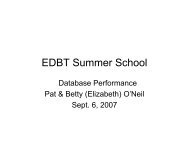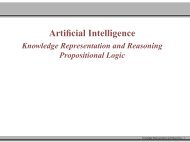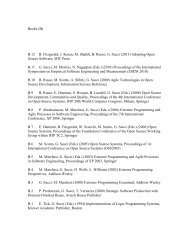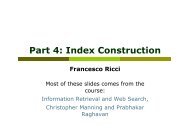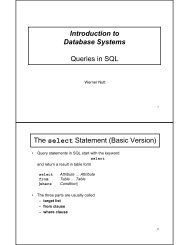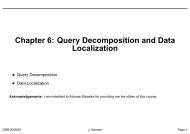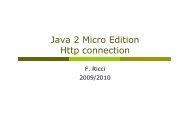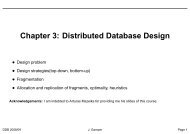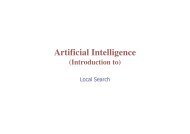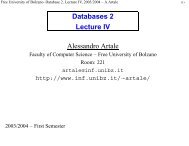Logic-based reasoning support for SBVR - Faculty of Computer ...
Logic-based reasoning support for SBVR - Faculty of Computer ...
Logic-based reasoning support for SBVR - Faculty of Computer ...
You also want an ePaper? Increase the reach of your titles
YUMPU automatically turns print PDFs into web optimized ePapers that Google loves.
<strong>Logic</strong>-<strong>based</strong> <strong>reasoning</strong> <strong>support</strong> <strong>for</strong> <strong>SBVR</strong><br />
Dmitry Solomakhin 1) , Enrico Franconi 2) , and Alessandro Mosca 2)<br />
Free University <strong>of</strong> Bozen-Bolzano, Italy<br />
Piazza Domenicani 3, 39100 Bolzano, Italy<br />
1) Dmitry.Solomakhin@stud-inf.unibz.it, 2) [surname]@inf.unibz.it<br />
Abstract. Automated <strong>support</strong> to enterprise modeling has increasingly<br />
become a subject <strong>of</strong> interest <strong>for</strong> organizations seeking solutions <strong>for</strong> storage,<br />
distribution and analysis <strong>of</strong> knowledge about business processes.<br />
This interest has recently resulted in approving the standard <strong>for</strong> specifying<br />
Semantics <strong>of</strong> Business Vocabulary and Business Rules (<strong>SBVR</strong>).<br />
Despite the existence <strong>of</strong> <strong>for</strong>mally grounded notations, up to now <strong>SBVR</strong><br />
still lacks a sound and consistent logical <strong>for</strong>malization which would allow<br />
developing automated solutions able to check the consistency <strong>of</strong> a set <strong>of</strong><br />
business rules. This work reports on the attempt to provide logical foundations<br />
<strong>for</strong> <strong>SBVR</strong> by the means <strong>of</strong> defining a specific first-order deonticalethic<br />
logic (FODAL). The connections <strong>of</strong> FODAL with the modal logic<br />
QK and the description logic ALCQI have been investigated and, on<br />
top <strong>of</strong> the obtained theoretical results, a special tool providing automated<br />
<strong>support</strong> <strong>for</strong> consistency checks <strong>of</strong> a set <strong>of</strong> ALCQI-expressible deontic and<br />
alethic business rules has been implemented.<br />
1 Introduction<br />
Automated <strong>support</strong> to enterprise modeling has increasingly become a subject <strong>of</strong><br />
interest <strong>for</strong> organizations seeking solutions <strong>for</strong> storage, distribution and analysis<br />
<strong>of</strong> knowledge about business processes. One <strong>of</strong> the most common approaches <strong>for</strong><br />
describing business and the in<strong>for</strong>mation used by that business is the rule-<strong>based</strong><br />
approach [4], which was adopted by the Object Management Group (OMG) <strong>for</strong><br />
a standard <strong>for</strong> specifying business objects and rules. The Semantics <strong>of</strong> Business<br />
Vocabulary and Business Rules (<strong>SBVR</strong>) [19] standard provides means <strong>for</strong> describing<br />
the structure <strong>of</strong> the meaning <strong>of</strong> rules, so called “semantic <strong>for</strong>mulation”,<br />
expressed in one <strong>of</strong> the intuitive notations, including the natural language that<br />
business people use [2] and Object-Role Modeling (ORM2) diagrams [8]. ORM2<br />
has recently become widely used as conceptual modeling approach combining<br />
both <strong>for</strong>mal, textual specification language and graphical modeling language [9].<br />
It consists in identifying and articulating the rules that define the structure<br />
(alethic) and control the operation (deontic) <strong>of</strong> an enterprise [18]. The main expectation<br />
from automated solutions built upon this approach is the ability to<br />
automatically determine consistency <strong>of</strong> business rules in a business model, so<br />
that they can be further exploited to build in<strong>for</strong>mation systems and relational<br />
databases that are coherent with the intended domain business logic.
Several attempts have been made so far in order to provide a logical <strong>for</strong>malization<br />
<strong>for</strong> structural and operational rules in <strong>SBVR</strong> and its notations. The most<br />
significant related work includes several <strong>for</strong>malizations <strong>of</strong> the purely structural<br />
fragment <strong>of</strong> ORM2, including translation to first-order predicate logic (FOL)<br />
[10] and some description logics (DL), e.g. [14] and [12]. However, none <strong>of</strong> the<br />
existing approaches enables consistency checks <strong>for</strong> a combined set <strong>of</strong> possibly<br />
interacting alethic and deontic business rules.<br />
In this paper we define a multimodal first-order deontic-alethic logic (FO-<br />
DAL) with sound and complete axiomatization that captures the desired semantics<br />
<strong>of</strong> and interaction between business rules. We then report on the logical<br />
properties <strong>of</strong> such <strong>for</strong>malization and its connections with the modal logic QK<br />
and the description logic ALCQI. Finally we present the tool which provides<br />
automated <strong>support</strong> <strong>for</strong> consistency checks <strong>of</strong> a set <strong>of</strong> ALCQI-expressible deontic<br />
and alethic ORM2 constraints. Additionally, it implements the translation <strong>of</strong><br />
a<strong>for</strong>ementioned class <strong>of</strong> ORM2 constraints into an OWL2 ontology.<br />
The rest <strong>of</strong> the paper is organized as follows. In the second section an overview<br />
<strong>of</strong> the <strong>SBVR</strong> standard and its ORM2 notation is given. Third section describes<br />
the proposed logical <strong>for</strong>malization in terms <strong>of</strong> first-order deontic-alethic logic<br />
(FODAL) along with its syntax, semantics and complete and sound axiomatization.<br />
Next two paragraphs are devoted to modeling <strong>SBVR</strong> rules with FODAL<br />
and checking their consistency with the help <strong>of</strong> this logic, while in the sixth<br />
section a connection with standard modal logic is introduced. Finally, the last<br />
paragraph describes the tool developed to provide automated <strong>support</strong> <strong>for</strong> consistency<br />
checks together with translation to OWL2.<br />
2 <strong>SBVR</strong> Overview<br />
A core idea <strong>of</strong> business rules <strong>for</strong>mally <strong>support</strong>ed by <strong>SBVR</strong> is the following [19]:<br />
“Rules build on facts, and facts build on concepts as expressed by terms. Terms<br />
express business concepts; facts make assertions about these concepts; rules constrain<br />
and <strong>support</strong> these facts”. The notions <strong>of</strong> terms and facts <strong>of</strong> this “business<br />
rules mantra” correspond to <strong>SBVR</strong> noun concepts and verb concepts (or fact<br />
types) respectively.<br />
Noun and verb concepts. According to the <strong>SBVR</strong> 1.0 specification [19]<br />
a noun concept is defined as a “concept that is the meaning <strong>of</strong> a noun or noun<br />
phrase”. It has several subtypes: object type, individual concept and fact type<br />
role. An object type is defined as “noun concept that classifies things on the<br />
basis <strong>of</strong> their common properties”, while individual concept is “a concept that<br />
corresponds to only one object [thing]”. A role is a “noun concept that corresponds<br />
to things <strong>based</strong> on their playing a part, assuming a function or being<br />
used in some situation”.<br />
A verb concept (or fact type) represents the notion <strong>of</strong> relations and is defined<br />
as “a concept that is the meaning <strong>of</strong> a verb phrase”. A fact type can have one<br />
(characteristic), two (binary) or more fact type roles.
Fig. 1. <strong>SBVR</strong> overview<br />
Business rules. The main types <strong>of</strong> rules defined in <strong>SBVR</strong> standard are<br />
structural business rules and operative business rules (See Figure 1). Structural<br />
(definitional) rules specify what the organization takes things to be, how do the<br />
members <strong>of</strong> the community agree on the understanding <strong>of</strong> the domain [5]. They<br />
define the characteristics <strong>of</strong> noun concepts and put constraints on verb concepts<br />
and can not be broken. Operative (behavioural) business rules are intended to<br />
describe the business processes in organization and can be either ignored or<br />
violated by people.<br />
Conceptual model. An <strong>SBVR</strong> conceptual model CM = 〈S, F 〉 is a structure<br />
intended to describe a business domain, where S is a conceptual schema,<br />
declaring fact types and rules relevant to the business domain, and F is a population<br />
<strong>of</strong> facts that con<strong>for</strong>m to this schema. Business rules defined in the conceptual<br />
schema S can be considered as high-level facts (i.e., facts about propositions)<br />
and play a role <strong>of</strong> constraints, which are used to impose restrictions concerning<br />
fact populations.<br />
The <strong>SBVR</strong> standard provides means <strong>for</strong> <strong>for</strong>mally expressing business facts<br />
and business rules in terms <strong>of</strong> fact types <strong>of</strong> pre-defined schema and certain logical<br />
operators, quantifiers, etc. These <strong>for</strong>mal statements <strong>of</strong> rules may be trans<strong>for</strong>med<br />
into logical <strong>for</strong>mulations, which can in turn be used <strong>for</strong> exchange with other<br />
rules-<strong>based</strong> s<strong>of</strong>tware tools. Such logical rule <strong>for</strong>mulations are equivalent to <strong>for</strong>mulae<br />
in 2-valued first-order predicate calculus with identity [19]. In addition to<br />
standard universal (∀) and existential (∃) quantifiers, <strong>for</strong> the sake <strong>of</strong> convenience,<br />
<strong>SBVR</strong> standard allows logical <strong>for</strong>mulation to use some pre-defined [8] numeric<br />
quantifiers, such as at-most-one (∃ 0..1 ), exactly-n (∃ n , n ≥ 1) and others.<br />
In order to express the structural or operational nature <strong>of</strong> a business rule, the<br />
corresponding rule <strong>for</strong>mulation uses any <strong>of</strong> the basic alethic or deontic modalities.<br />
Structural rule <strong>for</strong>mulations use alethic operators: □ = it is necessary that and<br />
♦ = it is possible that; while operative rule <strong>for</strong>mulations use deontic modal<br />
operators O = it is obligatory that, P = it is permitted that, as well as F = it<br />
is <strong>for</strong>bidden that.
Notations <strong>for</strong> business vocabulary and rules. There are several common<br />
means <strong>of</strong> expressing facts and business rules in <strong>SBVR</strong>, namely through<br />
statements, diagrams or any combination <strong>of</strong> those, each serving best <strong>for</strong> different<br />
purposes ([16], [19, Annex C, Annex L]). While graphical notations are<br />
helpful <strong>for</strong> demonstrating how concepts are related, they are usually impractical<br />
when defining vocabularies or expressing rules. We use r to denote a business<br />
rule in <strong>SBVR</strong> regardless the particular <strong>for</strong>mat in which it is written. For the<br />
sake <strong>of</strong> readability we will denote any necessity claim as r □<br />
, possibility claim as<br />
r ♦<br />
, obligation claim as r O<br />
and permission claim as r P<br />
.<br />
One <strong>of</strong> the most promising notations <strong>for</strong> <strong>SBVR</strong> is Object-Role Modeling<br />
(ORM2), which is a conceptual modeling approach combining both <strong>for</strong>mal, textual<br />
specification language and <strong>for</strong>mal graphical modeling language [9]. ORM2<br />
specification language applies to mixfix predicates <strong>of</strong> any arity and contains<br />
predefined patterns covering a wide range <strong>of</strong> constraints typical <strong>for</strong> business<br />
domains. An example <strong>of</strong> a structural rule expressed as necessity statement in<br />
ORM2 specification language is the following:<br />
r = Each visitor has at most one passport.<br />
An example illustrating ORM2 graphical notation is introduced on Figure 2.<br />
Fig. 2. Example <strong>of</strong> ORM2 diagram<br />
The advantage <strong>of</strong> ORM2 over other notations is that it is a <strong>for</strong>mal language<br />
per se, featuring rich expressive power, intelligibility, and semantic stability [11].<br />
There exist several translations from non-modal ORM2 expressions to standard<br />
logics, including translation to first-order logic ([10]) and some description logics<br />
([14], [7]). We will hereafter denote by φˆr a first-order representation <strong>of</strong> a nonmodal<br />
ORM2 expression 1 ˆr from a rule r. Similarly, we will denote by φ DL<br />
ˆr<br />
a<br />
description logic representation <strong>of</strong> a non-modal ORM2 expression ˆr.<br />
A<strong>for</strong>ementioned existing translations to standard logics may be seen as attempts<br />
to provide a logical <strong>for</strong>malization <strong>for</strong> structural and operational rules.<br />
However, since they consider only the purely structural fragment <strong>of</strong> ORM2, they<br />
are not capable <strong>of</strong> providing consistency checks <strong>for</strong> a combined set <strong>of</strong> possibly<br />
interacting alethic and deontic business rules.<br />
1 Since the nature <strong>of</strong> business rules implies the absence <strong>of</strong> uncertainty, it means that<br />
the resulting first-order <strong>for</strong>mulae will not contain free variables, i.e. will be closed<br />
<strong>for</strong>mulae. Then an <strong>SBVR</strong> rule may be represented by an expression resulted from<br />
application <strong>of</strong> modalities and boolean connectives to a set <strong>of</strong> closed FOL <strong>for</strong>mulae φ ˆri .
3 First-order deontic-alethic logic (FODAL)<br />
In this section we describe our attempt to provide logical foundations <strong>for</strong> <strong>SBVR</strong><br />
by the means <strong>of</strong> defining a specific multi-modal logic. The basic <strong>for</strong>malisms we<br />
use to model business rule <strong>for</strong>mulations are standard deontic logic (SDL) and<br />
normal modal logic S4, which are both propositional modal logics. We then<br />
construct a first-order deontic-alethic logic (FODAL) – a multimodal logic, as a<br />
first-order extension <strong>of</strong> a combination <strong>of</strong> SDL and S4 to be able to express business<br />
constraints defined in <strong>SBVR</strong>. In order to construct the first-order extension<br />
<strong>for</strong> the combined logic we follow the procedure described in [6].<br />
3.1 Syntax<br />
The alphabet <strong>of</strong> FODAL contains the following symbols:<br />
– a set <strong>of</strong> propositional connectives: ¬, ∧.<br />
– a universal quantifier: ∀ (<strong>for</strong> all).<br />
– an infinite set P = {P 1 1 , P 1 2 , ..., P 2 1 , P 2 2 , ..., P n 1 , P n 2 , ...} <strong>of</strong> n-place relation symbols<br />
(also referred to as predicate symbols).<br />
– an infinite set V = {v 1 , v 2 , ...} <strong>of</strong> variable symbols.<br />
– modal operators: alethic – □ (necessity) and deontic – O (obligation).<br />
FODAL <strong>for</strong>mulae. The <strong>for</strong>mulae <strong>of</strong> FODAL are defined inductively in the<br />
following way:<br />
– Every atomic <strong>for</strong>mula is a <strong>for</strong>mula.<br />
– If X is a <strong>for</strong>mula, so is ¬X.<br />
– If X and Y are <strong>for</strong>mulae, then X ∧ Y is a <strong>for</strong>mula.<br />
– If X is a <strong>for</strong>mula, then so are □X and OX.<br />
– If X is a <strong>for</strong>mula and v is a variable, then ∀vX is a <strong>for</strong>mula.<br />
The existential quantifier (∃) as well as other propositional connectives (∨, →, ↔)<br />
are defined as usual, while additional modal operators (♦, P , F ) are defined in<br />
the following way:<br />
♦φ ≡ ¬□¬φ P φ ≡ ¬O¬φ F φ ≡ O¬φ (1)<br />
A FODAL <strong>for</strong>mula with no free variable occurrences is called a closed <strong>for</strong>mula<br />
or a sentence. A modal sentence is a sentence whose main logical operator is a<br />
modal operator. An atomic modal sentence is a modal sentence which contains<br />
one and the only modal operator.<br />
3.2 Semantics<br />
Since <strong>SBVR</strong> itself interprets constraints in the context <strong>of</strong> possible worlds which<br />
correspond to states <strong>of</strong> the fact model (i.e. different fact populations), the choice<br />
<strong>of</strong> varying domain Kripke semantics is intuitively justified. Also, since <strong>SBVR</strong><br />
rule <strong>for</strong>mulations may includes two types <strong>of</strong> modalities: deontic and alethic, - we<br />
utilize the notion <strong>of</strong> two-layer Kripke frames with accessibility relations R O and<br />
R □ respectively.
Augmented frame. A varying domain augmented bimodal frame is a relational<br />
structure F var = 〈W, R O , R □ , D〉, where 〈W, R O , R □ 〉 is a two-layer<br />
Kripke frame, W is a non-empty set <strong>of</strong> worlds, R (·) are binary relations on W<br />
and D is a domain function mapping worlds <strong>of</strong> W to non-empty sets. A domain<br />
<strong>of</strong> a possible world w is then denoted as D(w) and a frame domain is defined as<br />
D(F) = ⋃ {D(w i )|w i ∈ W}.<br />
In order to correctly capture the behavior and interaction <strong>of</strong> the alethic and<br />
deontic modal operators it is necessary to constrain the corresponding accessibility<br />
relations: the alethic accessibility is usually taken to be a reflexive and<br />
transitive relation (S4) [3], while the behavior <strong>of</strong> a deontic modality is classically<br />
considered to be captured by a serial relation (KD) [15]. We refer to the<br />
corresponding class <strong>of</strong> bimodal frames as S4 ⊗ KD-frames.<br />
Moreover, since one <strong>of</strong> the objectives <strong>of</strong> <strong>for</strong>malization under development is<br />
to define the consistency <strong>of</strong> the set <strong>of</strong> business rules, it should also take into<br />
account the existing interaction between alethic and deontic modalities. The<br />
desired interaction can be verbalized as “Everything which is necessary is also<br />
obligatory” and then expressed as a following FODAL <strong>for</strong>mula:<br />
□X → OX (2)<br />
It can be proved that the <strong>for</strong>mula 2 defines a special subclass <strong>of</strong> S4⊗KD-frames.<br />
Theorem 1. The modal <strong>for</strong>mula □X → OX defines the subclass <strong>of</strong> augmented<br />
bimodal S4 ⊗ KD-frames F = 〈W, R O , R □ , D〉 such that R O ⊆ R □ , where R □<br />
is a preorder and R O is serial. We then call such frame a FODAL frame.<br />
Pro<strong>of</strong>: For the complete pro<strong>of</strong> refer to [17].<br />
Interpretation and model. An interpretation I in a varying domain augmented<br />
frame F var = 〈W, R O , R □ , D〉 is a function which assigns to each m-<br />
place relation symbol P and to each possible world w ∈ W some m-place<br />
relation on the domain D(w) <strong>of</strong> that world. I can be also interpreted as a<br />
function that assigns to each possible world w ∈ W some first-order interpretation<br />
I(w). An FODAL varying domain first-order model is a structure<br />
M = 〈W, R O , R □ , D, I〉, where 〈W, R O , R □ , D〉 is a FODAL frame and I is an<br />
interpretation in it.<br />
Truth in a model. The satisfiability relation between FODAL models and<br />
<strong>for</strong>mulae is then defined in the usual way, using the notion <strong>of</strong> valuation which<br />
maps variables to elements <strong>of</strong> the domain.<br />
Let M = 〈W, R O , R □ , D, I〉 be a FODAL model, X, Y and Φ be FODAL <strong>for</strong>mulae.<br />
Then <strong>for</strong> each possible world w ∈ W and each valuation σ on D(M) the<br />
following holds:<br />
– if P is a m-place relation symbol, then M, w σ P (x 1 , ..., x m ) if and only if<br />
(σ(x 1 ), ..., σ(x m )) ∈ I(P, w) or, equivalently, I(w) F OL<br />
σ P (x 1 , ..., x m ),<br />
– M, w σ ¬X if and only if M, w σ X,<br />
– M, w σ X ∧ Y if and only if M, w σ X and M, w σ Y ,<br />
– M, w σ ∀xΦ if and only if <strong>for</strong> every x-variant σ ′ <strong>of</strong> σ at w, M, v σ Φ,<br />
– M, w σ ∃xΦ if and only if <strong>for</strong> some x-variant σ ′ <strong>of</strong> σ at w, M, v σ Φ,
– M, w σ □X if and only if <strong>for</strong> every v ∈ W such that wR □ v, M, v σ X,<br />
– M, w σ ♦X if and only if <strong>for</strong> some v ∈ W such that wR □ v, M, v σ X,<br />
– M, w σ OX if and only if <strong>for</strong> every v ∈ W such that wR O v, M, v σ X,<br />
– M, w σ P X if and only if <strong>for</strong> some v ∈ W such that wR O v, M, v σ X.<br />
3.3 Axiomatization<br />
An F ODAL axiom system <strong>for</strong> first-order alethic-deontic logic is defined following<br />
the approach presented in [6] and is obtained by combining the axiom systems<br />
<strong>for</strong> the propositional modal logics S4 and KD and extending the resulting<br />
combination with additional axiom schemas and the axiom 9 reflecting desired<br />
interaction between alethic and deontic modalities.<br />
Axioms. All the <strong>for</strong>mulae <strong>of</strong> the following <strong>for</strong>ms are taken as axioms.<br />
(Tautologies S4) Any FOL substitution-instance <strong>of</strong> a theorem <strong>of</strong> S4 (3)<br />
(Tautologies KD) Any FOL substitution-instance <strong>of</strong> a theorem <strong>of</strong> KD (4)<br />
(Vacuous ∀) ∀xφ ≡ φ, provided x is not free in φ (5)<br />
(∀ Distributivity) ∀x(φ → ψ) → (∀xφ → ∀xψ) (6)<br />
(∀ Permutation) ∀x∀yφ → ∀y∀xφ (7)<br />
(∀ Elimination) ∀y(∀xφ(x) → φ(y)) (8)<br />
(Necessary O) □φ → Oφ (9)<br />
Rules <strong>of</strong> inference.<br />
φ φ → ψ<br />
(Modus Ponens)<br />
ψ<br />
φ<br />
(Deontic Necessitation)<br />
Oφ<br />
φ<br />
(Alethic Necessitation)<br />
□φ<br />
φ<br />
(∀ Generalization)<br />
∀xφ<br />
(10)<br />
(11)<br />
Theorem 2. The F ODAL axiom system is complete and sound with respect to<br />
the class <strong>of</strong> FODAL frames.<br />
Pro<strong>of</strong>: For the complete pro<strong>of</strong> refer to [17].<br />
4 Modeling <strong>SBVR</strong> vocabulary and rules with FODAL<br />
Given an <strong>SBVR</strong> conceptual schema S we define the following translation τ(·)<br />
from elements <strong>of</strong> S to notions <strong>of</strong> first-order deontic-alethic logic:<br />
– For each noun concept A from S, τ(A) is an unary predicate in FODAL.<br />
– For each verb concept R from S, τ(R) is an n-ary predicate in FODAL<br />
(n ≥ 2).<br />
Recall that an <strong>SBVR</strong> business rule may be represented by an expression resulted<br />
from application <strong>of</strong> modalities and boolean connectives to a set <strong>of</strong> closed firstorder<br />
<strong>for</strong>mulae φ ˆri . Then <strong>for</strong> each <strong>SBVR</strong> rule r from S, its FODAL <strong>for</strong>malization<br />
τ(r) is defined inductively as follows:
– τ(ˆr) = φˆr , where ˆr is an non-modal <strong>SBVR</strong> expression and φˆr is its first-order<br />
translation,<br />
– τ(¬r) = ¬τ(r),<br />
– τ(r 1 ◦ r 2 ) = τ(r 1 ) ◦ τ(r 2 ), ◦ ∈ {∧, ∨, →, ↔}, where r 1 and r 2 are rule<br />
<strong>for</strong>mulations,<br />
– τ(□ˆr) = □τ(ˆr) and τ(Oˆr) = Oτ(ˆr).<br />
Example 1. Assume the following set <strong>of</strong> business rules, expressed in <strong>SBVR</strong> Structured<br />
English:<br />
(r 1) Each car rental is insured by exactly one credit card.<br />
(r 2) Each luxury car rental is a car rental.<br />
(r 3) It is obligatory that each luxury car rental is insured by at least<br />
two credit cards.<br />
Then the corresponding FODAL <strong>for</strong>mulas are the following:<br />
τ(r 1 ) = ∀x∃ 1 y(CarRental(x) ∧ Insured(x, y)),<br />
τ(r 2 ) = ∀x(LuxuryCarRental(x) → CarRental(x)),<br />
τ(r 3 ) = O(∀x∃ ≥2 y(LuxuryCarRental(x) ∧ Insured(x, y))).<br />
While our F ODAL <strong>for</strong>malization <strong>of</strong> <strong>SBVR</strong> rules provides logical mechanism<br />
<strong>support</strong>ing rule <strong>for</strong>mulations with multiple occurrences <strong>of</strong> modalities, <strong>SBVR</strong><br />
standard mostly focuses on normalized business constraints [19, p.108] that may<br />
be expressed by rule statements <strong>of</strong> the <strong>for</strong>m <strong>of</strong> atomic modal sentences or by<br />
statements reducible to such a <strong>for</strong>m via mechanisms provided by F ODAL axiomatization.<br />
As a matter <strong>of</strong> fact, restricting the domain <strong>of</strong> interest only to such<br />
atomic modal rule <strong>for</strong>mulations allows to obtain some useful results concerning<br />
satisfiability reduction and connection to standard logics, as shown in [17].<br />
Hereafter we will only consider <strong>SBVR</strong> rules expressible in one <strong>of</strong> the following<br />
<strong>for</strong>ms <strong>of</strong> atomic modal sentences:<br />
□φ ♦φ Oφ P φ (12)<br />
where φ is any closed wff <strong>of</strong> first-order logic.<br />
In the case <strong>of</strong> having negation in front <strong>of</strong> the modal operator, we assume application<br />
<strong>of</strong> the standard modal negation equivalences in order to obtain the basic<br />
<strong>for</strong>m <strong>of</strong> the initial rule.<br />
FODAL regulation. A FODAL regulation Σ is a set <strong>of</strong> FODAL atomic<br />
modal sentences <strong>for</strong>malizing structural and operational rules <strong>of</strong> an <strong>SBVR</strong> conceptual<br />
schema S. We introduce the following designations:<br />
τ(r □<br />
) = □η,<br />
τ(r ♦<br />
) = ♦π,<br />
τ(r O<br />
) = Oθ, τ(r P<br />
) = P ρ,<br />
Σ = {□η 1 , ..., □η k , ♦π 1 , ..., ♦π l , Oθ 1 , ..., Oθ m , P ρ 1 , ..., P ρ n } (13)<br />
k∧ l∧<br />
m∧ n∧<br />
Σ ∧ = □η i ∧ ♦π i ∧ Oθ i ∧ P ρ i (14)<br />
i=1<br />
where every η i , π i , θ i , ρ i is a closed first-order logic <strong>for</strong>mula.<br />
i=1<br />
i=1<br />
i=1
5 Consistency <strong>of</strong> a set <strong>of</strong> business rules<br />
The final objective <strong>of</strong> the proposed <strong>for</strong>malization is to provide an automation<br />
solution with <strong>reasoning</strong> <strong>support</strong> <strong>for</strong> <strong>SBVR</strong> business modeling and business processes<br />
monitoring. It is well known that when <strong>reasoning</strong> about some particular<br />
universe <strong>of</strong> discourse, consistency is essential.<br />
Assume a FODAL regulation Σ representing a set <strong>of</strong> structural and operative<br />
business rules. The task <strong>of</strong> consistency check <strong>for</strong> Σ is defined as procedure<br />
which analyzes the given set Σ and decides whether none the rules contradict<br />
with each other, i.e. there is no <strong>for</strong>mula ψ such that Σ ⊢ ψ and Σ ⊢ ¬ψ.<br />
A FODAL regulation Σ is called internally inconsistent when the specified constraints<br />
do not contradict each other when the system is populated.<br />
We distinguish several types <strong>of</strong> inconsistency depending on types <strong>of</strong> modalities<br />
<strong>of</strong> rules involved. The set Σ is called alethic inconsistent if it is inconsistent<br />
and the minimal inconsistent set Σ ⊥ contains <strong>for</strong>mulae <strong>of</strong> only alethic nature,<br />
i.e. Σ ⊥ ⊆ Σ □ . The set Σ is called deontic inconsistent if it is inconsistent and<br />
the minimal inconsistent set Σ ⊥ contains <strong>for</strong>mulae <strong>of</strong> only deontic nature, i.e.<br />
Σ ⊥ ⊆ Σ O . Otherwise, if Σ ⊥ ⊆ Σ □ ∪ Σ O , the set Σ is called cross inconsistent.<br />
According to the completeness <strong>of</strong> the FODAL logic we have that Σ ψ if<br />
and only if there exists a FODAL model M and a possible world w in it, such<br />
that M, w Σ ∧ ¬ψ. There<strong>for</strong>e, it is sufficient to state the satisfiability <strong>of</strong> the<br />
conjunction <strong>of</strong> all <strong>for</strong>mulae <strong>of</strong> the set:<br />
Σ ∧ =<br />
k∧<br />
□η i ∧<br />
i=1<br />
l∧ m∧ n∧<br />
♦π i ∧ Oθ i ∧ P ρ i<br />
i=1<br />
Bearing in mind the fact that the regulation Σ may only contain FODAL atomic<br />
modal sentences and taking into account the properties <strong>of</strong> accessibility relations<br />
<strong>of</strong> the FODAL frame F, we can obtain the following result:<br />
Theorem 3. A FODAL regulation Σ ∧ = ∧ k<br />
i=1 □η i ∧ ∧ l<br />
i=1 ♦π i ∧ ∧ m<br />
∧ i=1 Oθ i ∧<br />
n<br />
i=1 P ρ i is FODAL-satisfiable if and only if each <strong>of</strong> the following <strong>for</strong>mulae<br />
N , O, Q j , P j is independently first-order satisfiable:<br />
N =<br />
k∧<br />
i=1<br />
i=1<br />
η i<br />
m∧ k∧<br />
O = θ i ∧<br />
Q j = π j ∧<br />
i=1<br />
η i<br />
k∧<br />
η i ,<br />
i=1<br />
i=1<br />
m∧ k∧<br />
P j = ρ j ∧ θ i ∧ η i ,<br />
i=1<br />
i=1<br />
(15a)<br />
(15b)<br />
∀j = −−−→ 1 . . . l (15c)<br />
i=1<br />
Pro<strong>of</strong>: For the complete pro<strong>of</strong> refer to [17].<br />
∀j = −−−→ 1 . . . n (15d)
Observe that satisfiability <strong>of</strong> N follows naturally from satisfiability <strong>of</strong> any Q j .<br />
The same holds <strong>for</strong> O and P j respectively. However, the satisfiability checks <strong>for</strong><br />
15a and 15b should be examined explicitly, since Σ may only contain necessity<br />
and obligation rules. Moreover, such definition allows to detect the actual source<br />
<strong>of</strong> unsatisfiability <strong>of</strong> the FODAL regulation Σ.<br />
Modularity <strong>of</strong> the approach. It should be noted that the developed approach<br />
<strong>of</strong> satisfiability reduction possesses a property <strong>of</strong> modularity, i.e. it does<br />
not depend on the <strong>for</strong>malism behind the rule bodies η i , θ i , π i and ρ i , as long as<br />
<strong>for</strong>malism-specific satisfiability relation is provided.<br />
6 Reduction from FODAL to monomodal logic QK<br />
As a matter <strong>of</strong> fact, the FODAL logic inherits the property <strong>of</strong> undecidability from<br />
both its component logics: standard predicate modal logics QS4 and QKD are<br />
undecidable [13]. However, decidability results have been obtained <strong>for</strong> several<br />
well-studied fragments <strong>of</strong> quantified modal logics [20]. This section defines a<br />
truth-preserving translation <strong>of</strong> atomic modal sentences <strong>of</strong> the FODAL logic into<br />
standard predicate modal logic QK, which allows to use those results.<br />
Monomodal simulating pointed frame. Given a FODAL frame<br />
F = 〈W, R O , R □ , D〉 and a possible world w 0 ∈ W, a monomodal simulating<br />
pointed frame F s w 0<br />
is defined as a tuple 〈W s , R s , D s , w 0 〉, such that:<br />
– W s includes w 0 and all its deontic and alethic successors:<br />
W s = {w 0 }∪{v | (w 0 , v) ∈ R O }∪{v | (w 0 , v) ∈ R □ } = |since R O ⊆ R □ and<br />
R □ is reflexive| = {v | (w 0 , v) ∈ R □ }.<br />
– R s = {(w 0 , v) | (w 0 , v) ∈ R □ }, and □ s , ♦ s are modal operators associated<br />
with R s .<br />
– D s is a domain function on W s such that D s (v) = D(v) ∪ {π Ds }, ∀v ∈ W s ,<br />
where π Ds /∈ D is a new service domain symbol.<br />
Since the definition <strong>of</strong> R s does not preserve specific properties <strong>of</strong> R O and R □ ,<br />
the resulting frame F s w 0<br />
belongs neither to serial nor to transitive nor to reflexive<br />
class <strong>of</strong> frames and there<strong>for</strong>e can be classified as a K-frame.<br />
Monomodal translation. Given a FODAL regulation Σ expressed as a<br />
conjunction <strong>of</strong> FODAL atomic modal sentences 14, a monomodal translation <strong>of</strong><br />
regulation MT R(Σ ∧ ) is defined inductively as follows:<br />
MT R(φ)<br />
= φ, where φ is an objective FODAL <strong>for</strong>mula,<br />
MT R(φ 1 ∧ φ 2 ) = MT R(φ 1 ) ∧ MT R(φ 2 ), where φ 1 and φ 2 are FODAL atomic<br />
modal sentences,<br />
MT R(□ψ) = □ s MT R(ψ), MT R(Oψ) = □ s (¬Π → MT R(ψ)),<br />
MT R(♦ψ) = ♦ s (MT R(ψ) ∧ Π), MT R(P ψ) = ♦ s (MT R(ψ) ∧ ¬Π),<br />
where ψ is a objective FODAL <strong>for</strong>mula and Π is a 0-place predicate symbol,<br />
i.e. propositional letter, encapsulating the nature <strong>of</strong> the original modality <strong>of</strong> the<br />
rules <strong>of</strong> possibility and permission.
Simulated pointed model. Given a FODAL model M = 〈F, I〉 and a<br />
possible world w 0 ∈ W, a simulated pointed model M s w 0<br />
is defined as a tuple<br />
〈F s w 0<br />
, I s 〉 such that:<br />
– F s w 0<br />
= 〈W s , R s , D s , w 0 〉 is a monomodal simulating pointed frame <strong>for</strong> F =<br />
〈W, R O , R □ , D〉 and a possible world w 0 ∈ W,<br />
– I s is a first-order interpretation on the frame F s w 0<br />
such that:<br />
• For each v ∈ W s and <strong>for</strong> every n-place predicate P , I s (P, v) = I(P, v),<br />
• For each v ∈ W s such that (w 0 , v) ∈ R O , I s (Π, v) = ∅,<br />
• For each v ∈ W s such that (w 0 , v) /∈ R O , I s (Π, v) = {π Ds }.<br />
We now state <strong>for</strong>mally that the translation given above is truth-preserving<br />
with respect to varying domain semantics.<br />
Theorem 4. For any FODAL regulation Σ, any FODAL model M and any<br />
possible world w 0 <strong>of</strong> a model, we have that<br />
M, w 0 Σ if and only if M s w 0<br />
, w 0 MT R(Σ), (16)<br />
where M s w 0<br />
is a simulated pointed model <strong>for</strong> M and w 0 .<br />
Pro<strong>of</strong>: For the complete pro<strong>of</strong> refer to [17].<br />
There<strong>for</strong>e, the truth-preserving translation MT R defined <strong>for</strong> FODAL regulations<br />
enables the transfer <strong>of</strong> decidability results from well-studied fragments <strong>of</strong> predicate<br />
modal logics ([20], [1]) to FODAL. In particular, the following fragments <strong>of</strong><br />
FODAL logic are decidable:<br />
– the set <strong>of</strong> atomic modal sentences with at most two variables,<br />
– the set <strong>of</strong> monadic atomic modal sentences, all predicate symbols in which<br />
are at most unary,<br />
– the set <strong>of</strong> atomic modal sentences, modal operators in which are applied to<br />
sub<strong>for</strong>mulas from the guarded fragment <strong>of</strong> first-order logic.<br />
7 Implementation <strong>of</strong> automated <strong>reasoning</strong> <strong>support</strong> tool<br />
7.1 General description <strong>of</strong> the tool<br />
The ORM2 automated <strong>reasoning</strong> <strong>support</strong> tool is implemented in Java and includes<br />
a parser <strong>for</strong> ORM2 Formal Syntax [7], a set <strong>of</strong> Java classes representing<br />
the ORM2 knowledge database, a translator into an OWL2 ontology and a<br />
modal <strong>reasoning</strong> engine using HermiT or FaCT++ as an underlying reasoner.<br />
The workflow diagram <strong>of</strong> the tool is depicted on Figure 3. Currently, the tool<br />
provides the following functionality:<br />
– Checking the consistency <strong>of</strong> a given ORM2 schema which may include both<br />
alethic (necessities and possibilities) and deontic (obligations and permissions)<br />
constraints. One <strong>of</strong> the advantages <strong>of</strong> the underlying approach is the<br />
straight-<strong>for</strong>ward possibility to determine whether the inconsistency is caused<br />
purely by alethic or deontic constraints or by their combination. Additionally<br />
to the result <strong>of</strong> the consistency check, the tool prints out the list <strong>of</strong> concepts<br />
which are involved in conflicting constraints.
– Translating a given ORM2 schema into OWL2 ontology which can then be<br />
saved in various <strong>for</strong>mats <strong>for</strong> further use. However, this translation does not<br />
<strong>support</strong> modalities in their diversity and, there<strong>for</strong>e, takes into account only<br />
structural constraints (i.e. alethic rules).<br />
Fig. 3. Workflow Diagram<br />
1 Neumont ORM Architect <strong>for</strong> Visual Studio<br />
2 PNA Group Discovery and Validation Assistant<br />
7.2 <strong>Logic</strong>al foundations <strong>of</strong> implementation<br />
The algorithm <strong>of</strong> the developed automated <strong>reasoning</strong> <strong>support</strong> tool relies on two<br />
fundamental results.<br />
Firstly, it implements the procedure defined in [7] to translate a set <strong>of</strong> constraints<br />
from ORM2 Formal Syntax to ALCQI description logic, which is in<br />
fact a fragment <strong>of</strong> OWL2. Since the implemented ORM2 <strong>reasoning</strong> procedure<br />
involves less expressive ALCQI logic as underlying <strong>for</strong>malism [17], it does not<br />
<strong>support</strong> <strong>reasoning</strong> about the following in<strong>for</strong>mation about the ORM2 conceptual<br />
schema:<br />
– frequency constraints on multiple roles,<br />
– generalized subset constraints on relations,<br />
• still <strong>support</strong>ed: simple case <strong>of</strong> stand-alone roles,<br />
• still <strong>support</strong>ed: special case <strong>of</strong> contiguous full-set <strong>of</strong> roles;<br />
– ring constraints (NB: drawback <strong>of</strong> mapping n-ary relations via reification).<br />
The same in<strong>for</strong>mation is lost by translating a given ORM2 schema into OWL2<br />
ontology.<br />
Secondly, in order to check the consistency <strong>of</strong> a set <strong>of</strong> business rules expressed<br />
in ALCQI-definable fragment <strong>of</strong> ORM2, we utilize the modularity <strong>of</strong> the approach<br />
defined in Section 5 and adapt the result <strong>of</strong> satisfiability reduction <strong>for</strong><br />
the case <strong>of</strong> general description logic DL. The satisfiability relation <strong>for</strong> ORM2 is<br />
then provided by the semantic-preserved translation from ORM2 Formal Syntax<br />
to ALCQI [7].
Theorem 5. A FODAL regulation Σ = {□η 1 , ..., □η k , ♦π 1 , ..., ♦π l , Oθ 1 , ..., Oθ m ,<br />
P ρ 1 , ..., P ρ n }, expressed in DL-definable fragment <strong>of</strong> ORM2, is internally consistent<br />
if and only if each <strong>of</strong> the following description logic <strong>for</strong>mulae N DL , O DL ,<br />
Q DL<br />
j<br />
, P DL<br />
j<br />
Q DL<br />
j<br />
is independently satisfiable in DL:<br />
N DL =<br />
= π j ⊓<br />
kl<br />
i=1<br />
kl<br />
i=1<br />
η i ,<br />
η i O DL =<br />
P DL<br />
j<br />
= ρ j ⊓<br />
ml<br />
i=1<br />
θ i ⊓<br />
ml<br />
i=1<br />
kl<br />
i=1<br />
θ i ⊓<br />
η i ,<br />
kl<br />
i=1<br />
η i (17)<br />
∀j = −−−→ 1 . . . n<br />
Thus, we can reduce the consistency <strong>of</strong> a given set <strong>of</strong> constraints to ALCQI<br />
satisfiability, which in turn can be interpreted as unsatisfiable concepts’ check<br />
in resulting OWL2 ontology. Indeed, whenever a <strong>for</strong>mula in ALCQI is unsatisfiable,<br />
it means that the concept definition expressed by this <strong>for</strong>mula contains a<br />
contradiction which prevents the concept from having a model, i.e. the concept<br />
is <strong>for</strong>ced to not have any instances, hence is unsatisfiable.<br />
7.3 Usage <strong>of</strong> the tool<br />
In the following section we will demonstrate the functionality <strong>of</strong> the implemented<br />
tool by means <strong>of</strong> a real-life example <strong>of</strong> its usage. The graphical user interface <strong>of</strong> a<br />
tool is introduced on Figure 5 and contains controls which allow to select an input<br />
file, underlying reasoner, output file and output <strong>for</strong>mat <strong>for</strong> resulting ontology (if<br />
needed). The consistency check <strong>for</strong> an input ORM2 schema is per<strong>for</strong>med after<br />
loading the input file and the result <strong>of</strong> the check is communicated by visual flag<br />
as well as by a detailed log in the corresponding window.<br />
Checking the consistency <strong>of</strong> a given ORM2 schema. In order to illustrate<br />
the functionality <strong>of</strong> the consistency check we will consider the ORM2<br />
schema obtained by merging two conceptual models (e.g. A and B) and depicted on<br />
the Figure 4. This schema contains the following set <strong>of</strong> conflicting business rules:<br />
(R A 1 ) Each car rental is insured by exactly one credit card.<br />
(R B 1 ) Each luxury car rental is a car rental.<br />
(R B 2 ) It is obligatory that each luxury car rental is insured by at least<br />
two credit cards.<br />
Fig. 4. Inconsistent ORM2 Schema<br />
The given set <strong>of</strong> constraints can be fully expressed in ALCQI description<br />
logic, there<strong>for</strong>e we can use the developed <strong>reasoning</strong> <strong>support</strong> tool <strong>for</strong> consistency<br />
check. The schema on Figure 4 is internally inconsistent with respect to obligation<br />
(R B 2 ) since the latter clearly contradicts the structural constraint (R A 1 )
which, together with is-a constraint on luxury car rental, simply does not <strong>support</strong><br />
more than one credit card. There<strong>for</strong>e, <strong>for</strong> any luxury car rental the obligatory<br />
cardinality constraint cannot be satisfied. The same conclusion is indeed inferred<br />
by the implemented tool on Figure 5.<br />
8 Conclusion<br />
Fig. 5. The Graphical User Interface<br />
In this paper we introduced a logical <strong>for</strong>malization <strong>of</strong> the Semantics <strong>of</strong> Business<br />
Vocabulary and Rules standard (<strong>SBVR</strong>) by defining a first-order deontic-alethic<br />
logic (FODAL) with its syntax, semantics and complete and sound axiomatization,<br />
that captures the semantics <strong>of</strong> and interaction between business rules.<br />
We also showed that satisfiability in FODAL logic may be reduced to a standard<br />
first-order satisfiability <strong>for</strong> a class <strong>of</strong> <strong>for</strong>mulas restricted to atomic modal<br />
sentences. Moreover, in order to establish a relationship with a standard logical<br />
<strong>for</strong>malism, we defined a truth-preserving translation from a fragment <strong>of</strong> bimodal<br />
FODAL into quantified monomodal logic QK, that can be used to facilitate the<br />
transfer <strong>of</strong> decidability results from well-studied fragments <strong>of</strong> predicate modal<br />
logics to FODAL.<br />
Finally we presented the ORM2 <strong>reasoning</strong> tool which provides an automated<br />
<strong>support</strong> <strong>for</strong> consistency checks <strong>of</strong> the conceptual model along with its translation<br />
to OWL2 ontology. The main functionality <strong>of</strong> the tool is a consistency check <strong>of</strong><br />
a set <strong>of</strong> ALCQI-expressible deontic and alethic business rules. Another important<br />
task <strong>support</strong>ed by the tool is translation <strong>of</strong> the a<strong>for</strong>ementioned fragment<br />
<strong>of</strong> an ORM2 schema into an OWL2 ontology, which, however, does not <strong>support</strong><br />
any modalities except necessity due to lack <strong>of</strong> notions representing deontic<br />
constraints in OWL2.<br />
The future research in the field <strong>of</strong> logical <strong>for</strong>malization <strong>of</strong> <strong>SBVR</strong> aims to study<br />
the problem <strong>of</strong> entailment with respect to possible interaction <strong>of</strong> alethic and<br />
deontic modalities. Another future course <strong>of</strong> work includes defining an approach<br />
to translate an ORM2 schema with its alethic and deontic rules to SWRL or<br />
some other extension <strong>of</strong> OWL2.
References<br />
1. Hajnal Andréka, Johan Van Benthem, and István Németi. Modal languages and<br />
bounded fragments <strong>of</strong> predicate logic, 1996.<br />
2. Donald E. Baisley, John Hall, and Donald Chapin. Semantic <strong>for</strong>mulations in <strong>SBVR</strong>.<br />
In Rule Languages <strong>for</strong> Interoperability. W3C, 2005.<br />
3. Patrick Blackburn, Maarten de Rijke, and Yde Venema. Modal <strong>Logic</strong>. Number 53 in<br />
Cambridge Tracts in Theoretical <strong>Computer</strong> Science. Cambridge University Press,<br />
UK, 2001.<br />
4. Paolo Ceravolo, Cristiano Fugazza, and Marcello Leida. Modeling semantics <strong>of</strong><br />
business rules. In Proceedings <strong>of</strong> the Inaugural IEEE International Conference On<br />
Digital Ecosystems and Technologies (IEEE-DEST), February 2007.<br />
5. Donald Chapin. <strong>SBVR</strong>: What is now possible and why? Business Rules Journal,<br />
9(3), 2008.<br />
6. Melvin Fitting and Richard L. Mendelsohn. First-order modal logic. Kluwer Academic<br />
Publishers, Norwell, MA, USA, 1999.<br />
7. Enrico Franconi, Alessandro Mosca, and Dmitry Solomakhin. ORM2: Syntax and<br />
semantics. Internal report, KRDB Research Centre <strong>for</strong> Knowledge and Data, 2011.<br />
8. Terry Halpin. A <strong>Logic</strong>al Analysis <strong>of</strong> In<strong>for</strong>mation Systems: Static Aspects <strong>of</strong> the<br />
Data-oriented Perspective. PhD thesis, Department <strong>of</strong> <strong>Computer</strong> Science, University<br />
<strong>of</strong> Queensland, 1989.<br />
9. Terry Halpin. Object-Role Modeling (ORM/NIAM). In Handbook on Architectures<br />
<strong>of</strong> In<strong>for</strong>mation Systems, pages 81–102. Springer-Verlag, 1998.<br />
10. Terry Halpin and Tony Morgan. In<strong>for</strong>mation Modeling and Relational Databases.<br />
Morgan Kaufmann Publishers Inc., San Francisco, CA, USA, 2 edition, 2008.<br />
11. Terry A. Halpin and Jan Pieter Wijbenga. FORML 2. In Ilia Bider, Terry A.<br />
Halpin, John Krogstie, Selmin Nurcan, Erik Proper, Rainer Schmidt, and Roland<br />
Ukor, editors, BMMDS/EMMSAD, volume 50 <strong>of</strong> Lecture Notes in Business In<strong>for</strong>mation<br />
Processing, pages 247–260. Springer, 2010.<br />
12. Rami Hodrob and Mustafa Jarrar. Mapping ORM into OWL 2. In Proceedings <strong>of</strong><br />
the 1st International Conference on Intelligent Semantic Web-Services and Applications,<br />
ISWSA ’10, pages 9:1–9:7, New York, NY, USA, 2010. ACM.<br />
13. G. E. Hughes and M. J. Cresswell. A New Introduction To Modal <strong>Logic</strong>. Routledge,<br />
1996.<br />
14. C. Maria Keet. Mapping the Object-Role Modeling language ORM2 into Description<br />
<strong>Logic</strong> language DLRifd. CoRR, abs/cs/0702089, 2007.<br />
15. Paul McNamara. Deontic logic. In Edward N. Zalta, editor, The Stan<strong>for</strong>d Encyclopedia<br />
<strong>of</strong> Philosophy. Fall 2010 edition, 2010.<br />
16. Ronald G. Ross. Principles <strong>of</strong> the Business Rule Approach. Addison-Wesley Longman<br />
Publishing Co., Inc., Boston, MA, USA, 2003.<br />
17. Dmitry Solomakhin. <strong>Logic</strong>al Formalization <strong>of</strong> Semantic Business Vocabulary and<br />
Rules. MSc thesis, <strong>Faculty</strong> <strong>of</strong> In<strong>for</strong>matics, Vienna University <strong>of</strong> Technology, http:<br />
//media.obvsg.at/AC07810206-2001, 2011.<br />
18. The Business Rules Group. Defining business rules. What are they really? Technical<br />
report, The Business Rules Group, 2001.<br />
19. The Object Management Group. Semantics <strong>of</strong> Business Vocabulary and Business<br />
Rules (<strong>SBVR</strong>). Formal specification, v1.0, 2008.<br />
20. Frank Wolter and Michael Zakharyaschev. Decidable fragments <strong>of</strong> first-order modal<br />
logics. J. Symb. Log., 66(3):1415–1438, 2001.



